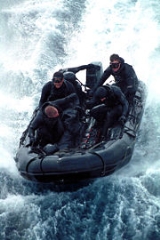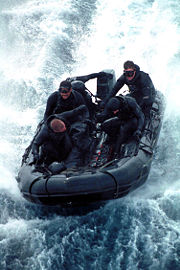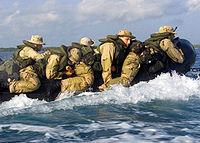
Combat Rubber Raiding Craft
Encyclopedia

Inflatable boat
An inflatable boat is a lightweight boat constructed with its sides and bow made of flexible tubes containing pressurised gas. For smaller boats, the floor and hull beneath it is often flexible. On boats longer than , the floor often consists of three to five rigid plywood or aluminium sheets fixed...
often used by United States Navy SEALs
United States Navy SEALs
The United States Navy's Sea, Air and Land Teams, commonly known as Navy SEALs, are the U.S. Navy's principal special operations force and a part of the Naval Special Warfare Command as well as the maritime component of the United States Special Operations Command.The acronym is derived from their...
and Marines
United States Marine Corps
The United States Marine Corps is a branch of the United States Armed Forces responsible for providing power projection from the sea, using the mobility of the United States Navy to deliver combined-arms task forces rapidly. It is one of seven uniformed services of the United States...
, among others. Though Zodiac Marine & Pool
Zodiac Marine & Pool
Zodiac Marine & Pool is a French company known for its boats and swimming pools; however they are best known for their widely used small inflatable boats.In 1998, the company acquired the Llanelli-based competitor Avon Inflatables...
produces a large range of both inflatable and rigid-hulled boats, the name "Zodiac" has become synonymous with the CRRC in popular culture.
Function
The boat can be used for over-the-horizon transportation, inserting lightly armed raiding parties or reconnaissance teams onto beaches, piers, offshore facilities and larger vessels. The CRRC can be inflated in minutes by foot pump, compressor or CO2 tank and can be deployed from shore and a variety of vessels. Additionally, it can be launched from several types of aircraft and submarines equipped with a special lockout chamber. Its chief advantages are light weight, compact size when stowed, and the safety imparted by its super-buoyant nature (which gives it the ability to operate in relatively high seas) stealth, and versatility.A total of eight individual airtight chambers comprise the F470. The main hull or gunwale
Gunwale
The gunwale is a nautical term describing the top edge of the side of a boat.Wale is the same word as the skin injury, a wheal, which, too, forms a ridge. Originally the gunwale was the "Gun ridge" on a sailing warship. This represented the strengthening wale or structural band added to the design...
contains five intercommunicating chambers, which are separated by internal baffle
Baffle
Baffle or baffles may refer to:* Baffle , a flow-directing vane or panel in some vessels such as shell and tube heat exchangers, chemical reactors, or static mixers...
s and valve
Valve
A valve is a device that regulates, directs or controls the flow of a fluid by opening, closing, or partially obstructing various passageways. Valves are technically pipe fittings, but are usually discussed as a separate category...
s. This means that a single leak will not result in loss of pressure throughout the boat, and that air can be bled between chambers to compensate for loss in one. Two additional chambers, located below the gunwale on either side and called "speed skags," provide cushioning for the boat's occupants and additional buoyancy
Buoyancy
In physics, buoyancy is a force exerted by a fluid that opposes an object's weight. In a column of fluid, pressure increases with depth as a result of the weight of the overlying fluid. Thus a column of fluid, or an object submerged in the fluid, experiences greater pressure at the bottom of the...
in case of pressure loss in the hull. The final chamber is an inflatable keel tube which runs the length of the craft and gives the bottom of the hull a "V" shape, imparting directional stability and additional shock absorption. A wooden "transom" board at the stern provides a mounting point for the outboard engine(s) and a "thrustboard" at the bow keeps the hull from collapsing inward under power.

A specially-trained coxswain sits at the stern (rear) of the boat and controls it via the tiller arm, attached to an outboard engine. The coxswain is considered the commander of the craft and is ultimately responsible for its operation, regardless of whether a senior-ranking individual is on board. Across from him sits the assistant coxswain, who relays hand signals from other boats and aids the coxswain as required. The remaining passengers (six raiders plus the two coxswains make up a full team) normally lay on and straddle the gunwale, keeping a low silhouette to help avoid detection and leaving room on the deck for weapons, equipment and (if necessary) additional fuel bladders.
Because the CRRC offers no protection to its occupants and is itself highly vulnerable to small-arms fire, operations involving it almost always take place at night and depend on the elements of stealth and surprise. However, Zodiac now offers ArmorFlate, the world's first inflatable bulletproof system for inflatable boats. It can be installed on the Zodiac F470, and inflates in 40 seconds. Demonstration occurred at the 2002 Multi-Agency Craft Conference at Naval Amphibious Base -Little Creek, Norfolk, Virginia, June 18–20, says an "Advanced Materials & Composites News" article.
Zodiac boats are not limited to military use. They are often chosen for law enforcement, search and rescue, and hobbyists.
Specifications
- Length 4.7 m (15'5")
- Width 1.9 m (6'3")
- Empty weight 146 kg (322 lb)
- Max engine weight 110 kg (243 lb)
- Max passengers: 10
- Max payload (including fuel): 1,250 kg (2,756 lb)
- Max range: varies depending on fuel load and payload

